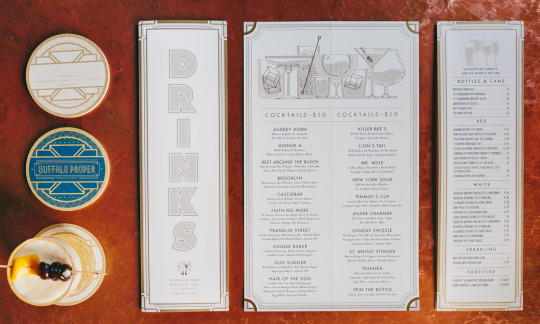Block Club is passionate about doing work for up-and-coming restaurants. In the last few years we have seen a flood of talented friends opening fantastic places to wine and dine in Buffalo and beyond, and it has been our pleasure to work with Buffalo Proper, Oshun, The Black Sheep, Big Ditch, Ristorante Lombardo and still more to be revealed from our current client roster.
Restaurants offer such a fun little microcosm of branding, with all of the satisfaction from doing a ground-up branding project on a compact scale from the identity, to the stationery, to the website, to the interior and of course, the menus. Geesh, we have done a lot of menus in the last year, made some mistakes and learned a ton.
Here are some quick tips I’ve picked up along the way for menu design success (on designer’s side and chef’s side too!):
1. Pre-printed menu blanks
My designer compatriot, Tim, touched on this concept in his post on better restaurant branding. Restaurant trends are constantly evolving and “farm-to-table” has become so ubiquitous that it is nearly passé, but on the whole, chefs today expect to be able to change their menu frequently as seasonal ingredients come and go, often weekly or even daily. To accommodate this, we design and pre-print menu blanks, with borders, illustrations and other artistic elements; menu content is filled in later, using the template we design, and are printed in-house at the restaurant. Not only does this make it easier for the chefs to produce a beautiful, evolving menu in-house, but it also allows us to select more premium paper stocks and printing techniques, such as offset printing, foil stamping, embossing or metallic PMS colors to enhance the design.

2. Allow for as open and airy of a layout as possible
Obviously form follows function in menu design, and the menu should always be designed to follow the chef’s instructions and not the other way around, but we would always encourage a restrained approach to the number of dishes, cocktails, bottles of wine, appetizers that you are squeezing onto a single menu. Not only is a menu with a little white space easier on the eyes, but I think it is easier to navigate and less overwhelming as well. Rather than trying to squeeze one hundred bottles of wine onto a single half sheet of legal paper, consider if a separate booklet or flipbook is a better option. Can the dish descriptions be simplified? Are those two cocktails so similar that they compete? Anywhere you can streamline content will help for a tidier menu design.

3. Consider the whole experience
I’m a person who loves to eat at the bar when I go out to eat. I like being in the thick of it, watching bartenders make drinks. I think there is something more romantic and intimate about sitting knee-to-knee with someone on a couple of barstools. Some people hate sitting at the bar and will only sit at a table. Some people like to show up early, get a drink at the bar and a quick appetizer, and then take a table. You need to consider the variety of door-to-check dining experiences and design an easy-to-use system of menus to accommodate all guests. Should you include all food and drinks on one giant menu, or have a separate drink list with bar snacks? Do you need to have a happy hour menu or will you write it on a board daily? Designing a smart system of menus helps things run more smoothly, and eliminates waste (i.e. not having drinks spilled on half of your stock of food menus every Friday happy hour).

4. Choosing the right paper/holder for the job
This is a really simple one, but it is so important: choose the nicest paper you can afford. Throwaway daily specials can go on a more lightweight, cost-effective stock, but cocktail menus should go on something more substantial if they are going to be handled more between the bar and tables. If you’re going with lighter paper weights, what will hold the menu? The options are endless and get more creative by the day. You could go with a classic, high-quality menu sleeve, or you could get creative and make your own menu boards of any material, sheets affixed with rubber bands, clips, any kind of grommet, duct tape, chewing gum, you name it. A personal favorite project of mine was our menu system for The Black Sheep, where we wheat-pasted vintage illustrations of farm life onto custom cut-wood menu boards and attached the menus with bright green rubber bands. Whatever you do, make sure it looks good and is durable! And as Tim advises: respect the paper.
Good luck!
